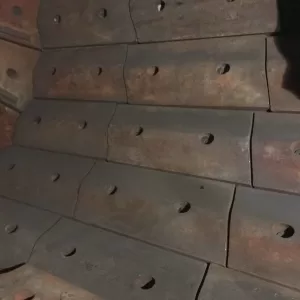
How to Address Liner Wear and Enhance Ball Mill Productivity in the Cement and Metallurgy Industries
Ball mills are crucial equipment in mineral processing plants, representing a significant investment in the construction of these facilities. Ensuring the grinding efficiency and longevity of ball mills is vital, and a major factor in achieving this is the condition and quality of the ball mill liners. These liners not only protect the mill’s cylindrical shell but also enhance the impact and grinding action of the media and materials within the mill. However, ball mill liners are subject to rapid wear. This article discusses the causes of this wear and offers strategies to improve the mill’s performance and lifespan.
Causes of Rapid Ball Mill Liner Wear and Solutions
1. Selection of Grinding Media and Liners
Hardness Ratio: The hardness ratio between the ball mill liners and the grinding media should be maintained between 0.8 and 0.9. The hardness of the grinding media should be 1.7 times that of the material being ground.
Material Composition: High manganese steel liners (ZGMn13) are recommended after heat treatment as they transform into austenite, providing both hardness and toughness.
Adjusting Ball Diameter: Properly determine the size of the grinding balls to optimize impact and wear.
2. Low Load Operation
Adjust Feed Rate: During low-load operation, adjust the feed rate to ensure optimal grinding and reduce direct impacts on the liners.
3. Design Improvements
Arc-shaped Bolt Holes: Design the liner’s fixing and wedge bolt holes in an arc shape to prevent stress concentration and subsequent cracking.
4. Controlling Coal Quality
Reduce Impurities: Strictly control the coal quality to reduce the content of coal gangue and improve the grindability index of the coal.
5. Pre-treating New Liners
Initial Use with Softer Balls: For new liners, use slightly softer grinding balls for the first 1-2 months to allow the liners to harden properly. Once the liners’ hardness and toughness have improved, switch to harder grinding balls to extend liner life.
6. Timely Defect Elimination
Maintenance and Inspection: Regularly inspect and promptly address equipment defects to prevent extensive liner damage and ensure safe and economical operation.
7. Ensuring Installation Quality
Proper Fit: Ensure liners fit well with the mill cylinder. Misaligned or improperly fitted liners should be replaced or adjusted.
Proper Fixing: Avoid forcing bolts that don’t align with the holes. After installation and adjustment, re-tighten the fixing bolts to ensure they have sufficient pre-tension to prevent loosening during operation.
Wear Due to Grinding Media Interaction
Ball mill liners and grinding balls are both consumables subject to wear. The continuous operation of the mill results in significant wear due to the constant impact and friction between the balls, liners, and materials. The hardness of the material being ground directly affects the wear rate of the liners and balls. Harder materials result in faster wear and potential equipment damage. Additionally, the size and quantity of the grinding balls also influence the wear rate. Larger or more numerous grinding balls increase the impact on the liners.
Solutions:
Proper Selection: Choose the appropriate liners and grinding balls based on their relative hardness.
Balanced Ratio: Maintain an optimal material-to-ball ratio, ideally with the material being twice the volume of the grinding balls.
Compatibility: Select liners that match the type of minerals being processed, and ensure the hardness of the balls and liners are compatible.
Heat Treatment Process Issues
Improper heat treatment of ball mill liners can increase wear and reduce their yield strength, leading to bolt breakage under shear forces. This occurs when staff lack understanding of the material properties and the necessary heat treatment process, resulting in insufficient liner reinforcement.
Solutions:
Preheating Liners: Preheat liners according to their material properties to reduce wear and improve their durability.
Abnormal Operating Conditions
Operating the ball mill under abnormal conditions can also accelerate liner wear. Normally, the grinding balls mix with the material and provide a buffering effect, gradually grinding the material finer. However, during low-load operation, grinding balls directly impact the liners, causing severe wear and potential fractures.
Solutions:
Adjust Feed Rate: Adjust the feed rate according to the mill’s operating conditions to ensure sufficient material presence and improve grindability.
In addition to the above causes, improper design, manufacturing, and installation can also lead to rapid wear of ball mill liners. Understanding these factors and addressing them systematically is essential for improving the efficiency and lifespan of ball mill liners.
For more information on ball mill liner maintenance and replacement, contact Econe Machine.



